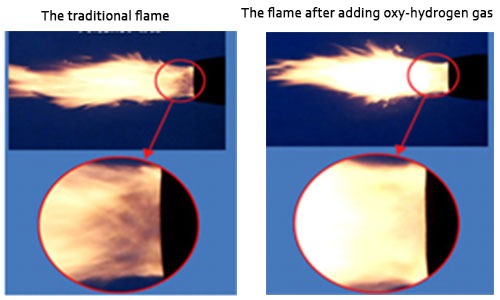Usages in catalytic combustion
Application in Industrial boiler Energy-saving field
As we know, the fuel adopted by boiler is mostly coal, oil, diesel and etc. All these fuels are macromolecules hydrocarbons which are hard to combust sufficiently. If you want to achieve that, you need to add much air. But adding excessive air will reduce the furnace box temperature because air needs to be heated and expel from air outlet. On the other side, the purity of oxygen in air is just 21% and nitrogen’s is 79%, so adding much air will increase the emission of NOx (exhaust gas). Thus, when air is too less and fuel can’t be combusted completely, heat value can’t be used sufficiently; when air is too much and exhaust heat loss, heat value can’t also be used sufficiently. So the boiler, which adopts air to support combustion, is hard to achieve the ideal state of combustion and the efficiency is just about 60% generally.

The Oxy-hydrogen combustion has the following characteristics:
(1)A kind of gaseous catalytic, superior unique catalytic property
(2)Clean and high efficiency, no second pollution
(3)Suppress the generation of dioxins
(4)Added from the air inlet, simple, safe, low cost and wide application
(5)Reduce NOx emission significantly
The technology has changed the traditional combustion way and significantly reduced the fuel consumption. It’s fully in correspondence with energy saving and low emission, recycle and low-carbon economy concept. It’s a revolutionary new energy technology because of its perfect characteristics and roles on minimizing raw materials, reusing, and recycling. It has a good market prospect in extensive industries like hazardous wastes incineration, municipal wastes incineration, thermoelectric generation, industrial heating furnace catalytic combustion, and so on.
1.Oxy-hydrogen used in industrial furnace
The industrial heating furnace mainly includes industrial boiler, industrial stove, chemical heat treatment, drying processing, municipal central heating boiler, etc. The three key technologies of the industrial heating furnace are to raise the combustion level, to improve the heat exchanging rate, and to lower the system operation and maintenance coats. The Oxy-hydrogen burning technologies of the industrial heating furnace meet the three key requests.
The industrial heating furnace is important equipment for manufacturing, but it’s also a large fuel consumption equipment. Most Chinese industrial fuel burners (different with the industrial electric burner) stand on a low integral level, so it wastes a lot of raw material with low fuel utilization efficiency. And it’s combined efficiency of processing, transformation, transportation and terminal using is only 31%~32% which is 10% lower than the international advanced level. Therefore, the high efficient oxy-hydrogen combustion technology can satisfy the requirements to lower the industrial heating furnace fuel consumption (an improved energy saving combustion technology) at the moment. It’s not only in line with the government energy policy, but also enjoys all the favorable conditions at the present worldwide high oil price situation.
2.Oxy-hydrogen used in medical care, industrial and household wastes incinerator
In china, the cities produce average 440kg wastes per person per year, and the national annual total output is more than 150 million tons and still with an increase rate of 8%~10% per year. Compared with the landfill and composting, the wastes incineration is more broadly used for efficient heat recovery, decontaminate, minimizing and recycling purpose. There are some wastes incineration power plants with wastes treatment capacity of more than 1000 tons/day which have been put in schedule or already founded in some large and medium-sized city, such as Beijing, Shanghai, Guangzhou, Shenzhen, Ningbo, Hangzhou, and so on. The foundation of wastes treatment and incinerator center can relieve the municipal wastes processing pressure and conserve the land, but it also has brought lots of problems. The wastes incineration secondary pollution (especially the dioxin) has increasingly become a prominent problem in home and abroad. The dioxin is regarded as a first class toxicant and the 2, 3, 7, 8-TCDD in it has a toxicity of 1000 times higher than the potassium cyanide (KCN). The dioxin is called as” the most toxic poison on the earth”. In view of this, “Stockholm Convention on Persistent Organic Pollutants” is put out to control the dioxin emission, and China, as one of signatory countries, also published “Technical requests for medical wastes incinerator” (GBI 9218-2003) and “household wastes control standard” (GBI8485-2001). To apply for the oxy-hydrogen in dangerous wastes and garbage incineration technology, it will not only improve the furnaces combustion efficiency and lower the soot and CO emission, but also inhibit the dioxin generation. Recently, some of similar products and applications appeared in domestic and international market has indicated a good market prospect, significant economic and social benefit.
3.Oxy-hydrogen used in clean coal combustion technology
China is the biggest coal producing country and consuming country in the world. The coal accounts 75% of the country’s total energy demand. Therefore, the coal occupies an important strategy position in China’s energy consumption and a coal-dominated energy structure won’t be changed in a short period. In China, the coal-electric conversion efficiency is very low (average rate of 32% in China, and 40-50% in developed countries, the coal consumption of the coal-fired generating unit is 379g/KWh in 2004 in China, which is 60g higher than the world advanced level), and the pollution is very high (80% of the air pollution is from fuel combustion), which lead to a high production cost and a bottleneck in coal-fired power plant construction. Therefore, to enhance the coal-electric conversion rate and to save the coal resources would be the most key purposes in the future, it is an important leverage to carry out the coal-fired power plant sustainable development. The oxy-hydrogen catalytic combustion technology is not only a complement and improvement to the Clean Coal Technology (CCT), but also fixes up a new technical route. The oxy-hydrogen generator has an enormous and potential market as auxiliary equipment in thermal power stations.
